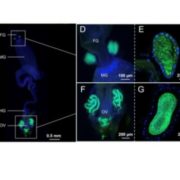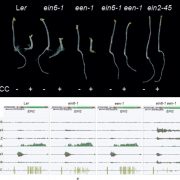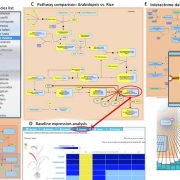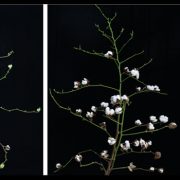The histone H3 variant H3.3 regulates gene body DNA methylation in Arabidopsis thaliana
 The histone H3 variant H3.3 is distinguished by its expression throughout the cell cycle, while H3.1 is expressed predominantly during DNA replication. Genome-wide ChIP studies in plants have shown that H3.3 is associated with actively transcribed genes, and enriched near the transcriptional end sites. This pattern also overlaps with the enrichment of RNA Polymerase II. DNA methylation frequently occurs over bodies of actively transcribed genes in animals and vascular plants. In Arabidopsis, profiles of gene body methylation overlap with enrichment for H3.3. To understand the mechanism involved, Wollmann et al., engineered H3.3 knock down in A. thaliana. They observed a reduction in transcription of environment responsive genes and transcription-dependent increase in linker histone H1 distribution over gene bodies. Their data also suggest that H3K36 methylation and other transcription-related H3 modifications do not seem to play any role in gene body methylation. Finally, the authors propose a mechanism wherein H3.3 prevents the recruitment of H1, which in turn inhibits H1’s promotion of chromatin folding to restrict access to DNA methyltransferases. Thus, H3.3 helps provide access to methyltransferases and likely shapes transcription-dependent gene body methylation patterns in Arabidopsis. Genome Biol. 10.1186/s13059-017-1221-3 (Contributed by Sunil Kumar K R)
The histone H3 variant H3.3 is distinguished by its expression throughout the cell cycle, while H3.1 is expressed predominantly during DNA replication. Genome-wide ChIP studies in plants have shown that H3.3 is associated with actively transcribed genes, and enriched near the transcriptional end sites. This pattern also overlaps with the enrichment of RNA Polymerase II. DNA methylation frequently occurs over bodies of actively transcribed genes in animals and vascular plants. In Arabidopsis, profiles of gene body methylation overlap with enrichment for H3.3. To understand the mechanism involved, Wollmann et al., engineered H3.3 knock down in A. thaliana. They observed a reduction in transcription of environment responsive genes and transcription-dependent increase in linker histone H1 distribution over gene bodies. Their data also suggest that H3K36 methylation and other transcription-related H3 modifications do not seem to play any role in gene body methylation. Finally, the authors propose a mechanism wherein H3.3 prevents the recruitment of H1, which in turn inhibits H1’s promotion of chromatin folding to restrict access to DNA methyltransferases. Thus, H3.3 helps provide access to methyltransferases and likely shapes transcription-dependent gene body methylation patterns in Arabidopsis. Genome Biol. 10.1186/s13059-017-1221-3 (Contributed by Sunil Kumar K R)








